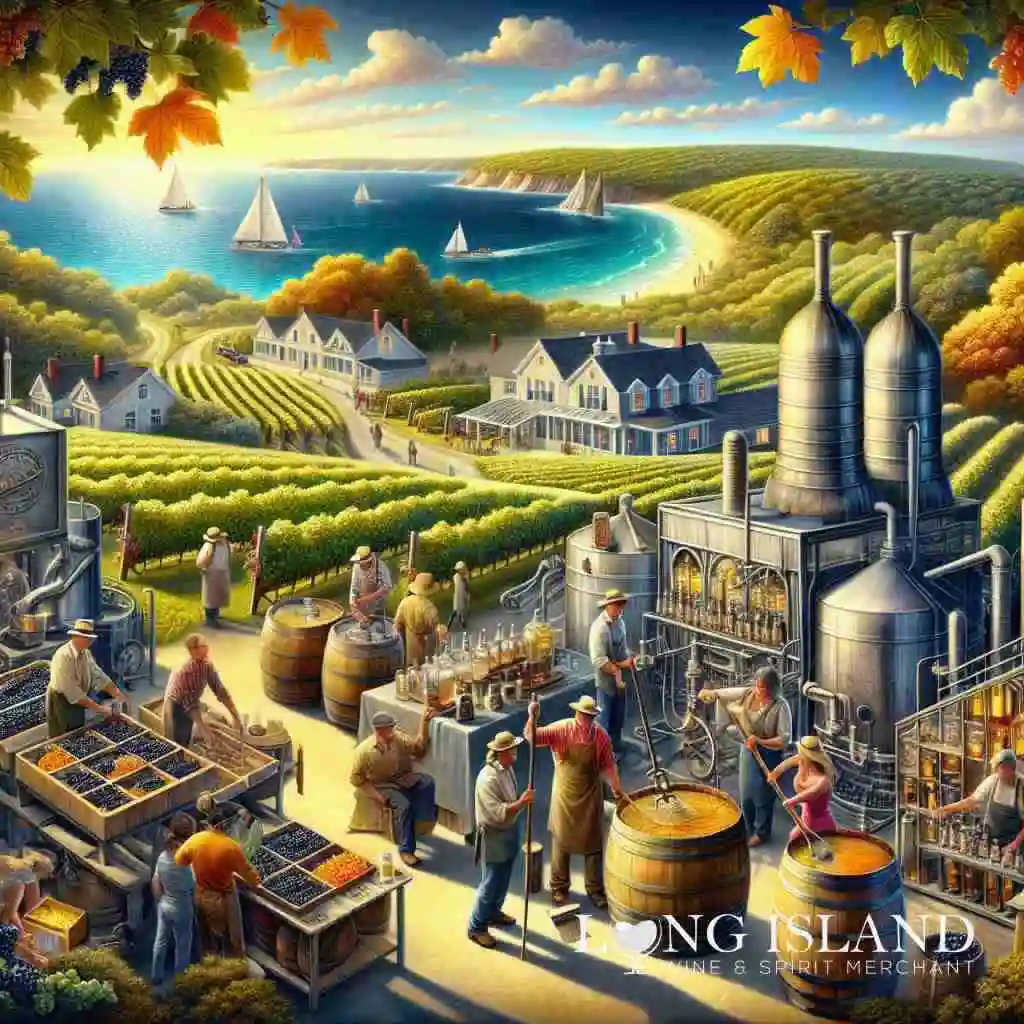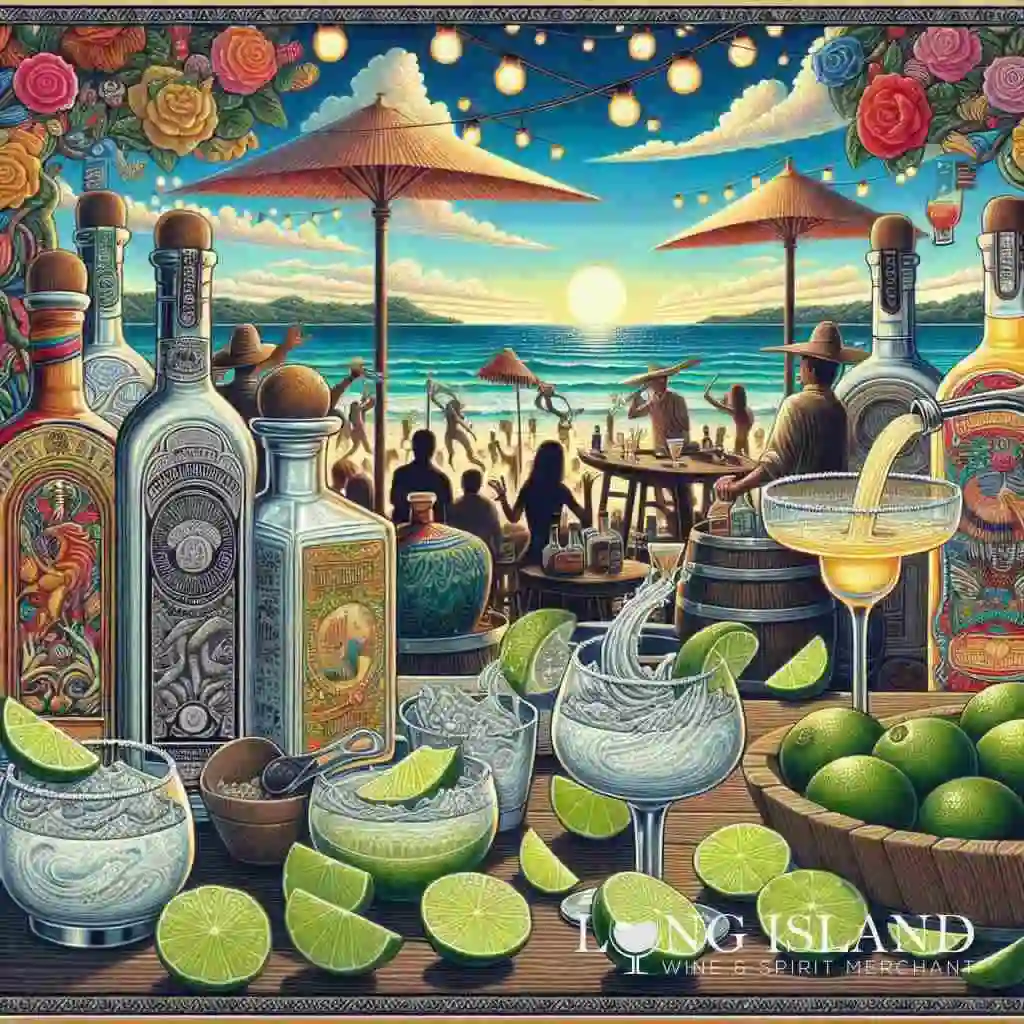
Ultimate Long Island Wine Pairing Guide for Beginners
May 10, 2024
Introduction to Long Island Wine Pairings
Exploring the Richness of Long Island Wines
Long Island, a revered wine-producing region, is home to vineyards that span from the sandy soils of the North Fork to the lush landscapes of the South Fork. This geographical diversity, combined with the maritime climate, breeds a remarkable variety of wines, making Long Island wineries a treasure trove for enthusiasts and novices alike. The craftsmanship visible in every bottle comes from a deep understanding of the land and a commitment to sustainable viticulture, ensuring each wine is a true expression of its terroir. Whether you’re drawn to the robust flavors of Long Island red wines or the crisp freshness of the whites, the region offers a spectrum of flavors waiting to be explored.
Why Wine Pairing Enhances Your Dining Experience
Wine pairing is an art that elevates the dining experience, creating harmony between food and drink that can enhance the flavors of both. Understanding the relationship between different types of wines and food textures, flavors, and aromas can transform a simple meal into an exquisite culinary adventure. This synergy is why wine pairing is central to gourmet dining, allowing each element on the plate and in the glass to shine. The nuanced characteristics of Long Island wines, with their unique flavor profiles, present endless possibilities for pairing, promising to enrich any meal with an additional layer of gustatory delight.
The Basics of Wine Pairing for Beginners
Entering the world of wine pairing can seem daunting to beginners, but a few basic principles can simplify the process. Firstly, it’s vital to consider the intensity of flavors – lighter wines like Long Island white wines or rosés pair well with delicate dishes, while robust Long Island reds complement heartier meals. Understanding the balance of acidity, sweetness, and tannins in wine can also guide pairing decisions, as these elements interact with food in different ways. For example, the crisp acidity in a Sauvignon Blanc can cut through the richness of a creamy sauce, while the gentle sweetness of a Riesling balances the heat in spicy dishes. Experimentation and exploration are key, with personal preference always taking precedence. As you begin your journey into wine pairing, remember that the ultimate goal is to enhance your enjoyment of both the wine and the meal.
Understanding Long Island Wine Varieties
Long Island’s viticulture has been flourishing, contributing significantly to the noteworthy array of wines available today. Beyond their immediate appeal, these wines tell a story of a region’s passion, climate, and terroir, offering an exciting journey for those willing to explore. Each variety from this unique region presents its layer of complexity and pairing potential, making Long Island a notable stop on the global wine map.
Overview of Long Island Red Wine
Long Island is renowned for producing red wines with depth and character, a testament to the region’s ideal wine-growing conditions. Long Island red wines stand out for their structure and complexity, attributes that owe much to the cool climate, a lengthy growing season, and adept winemaking. Varietals such as Merlot, Cabernet Franc, and Syrah shine here, with each offering its unique expression of Long Island’s rich terroir. These reds, known for their balanced tannins and notes ranging from ripe berries to earthy undertones, provide a robust canvas for food pairing, elevating dishes from simple grilled meats to intricate stews.
Discovering Long Island White Wine
The counterpart to its red siblings, Long Island white wines embody freshness, acidity, and aromatic nuance, capturing the essence of Long Island’s maritime influence. Varieties like Chardonnay, Sauvignon Blanc, and Riesling thrive in this terroir, yielding wines that are as versatile as they are delightful. These wines, with their spectrum from crisp and mineral-driven to rich and oak-aged, promise a match for a multitude of culinary options, from fresh seafood to creamy pasta dishes.
The Elegance of Long Island Rosé Wine
Rosé wine, with its charming hue and versatile profile, has a special place in Long Island’s wine portfolio. Produced primarily from Merlot and Cabernet Franc grapes, Long Island rosé wines balance between the lightness of whites and the depth of reds, making them perfect for year-round enjoyment. Their refreshing acidity and berry flavors lend themselves brilliantly to both casual sipping and food pairings, blurring the lines between seasons and dining settings with grace.
Celebratory Vibes with Long Island Sparkling Wine
Sparkling wine from Long Island is a testament to the area’s ability to produce wines that can stand shoulder-to-shoulder with the world’s best. Utilizing traditional methods for sparkling wine production, Long Island vintners craft bubblies that range from elegantly dry to delightfully sweet, encapsulating the festive spirit with every sip. These sparkling wines, with their effervescence and complexity, are perfect for celebrations and pair wonderfully with everything from delicate appetizers to hearty mains.
The decadence of Long Island Dessert and Fortified Wines
In the realm of sweet indulgence, Long Island’s dessert and fortified wines offer a lush escape for the senses. These Long Island dessert wines are crafted with care, often from late-harvest grapes that concentrate flavors and sugars, resulting in wines that are rich, aromatic, and beautifully sweet. Whether sipping alongside a dessert, enjoying the dessert itself, or relishing in the complexity that pairing these wines with savory dishes brings, they are a fitting finale to any dining experience.
Exploring Long Island’s wine varieties opens up a world of flavors, textures, and pairing possibilities. From the robust and hearty reds to the fresh and delicate whites, and the versatile rosés to the celebratory sparklings and decadent dessert wines, Long Island offers a spectrum of wines that cater to every palate and occasion.
Pairing Wine with Seafood
Best Wine for Seafood: A Guide
Pairing wine with seafood can seem like navigating through treacherous waters for beginners, but it offers a rewarding journey with each harmonious sip and bite. The key is to start with wine-for-seafood pairing principles that prioritize the weight and texture of the seafood dish alongside the wine’s character. Delicate fish like tilapia or cod pairs beautifully with light and zesty whites, such as Pinot Grigio, offering a palate-cleansing effect that elevates the dish’s subtle flavors. On the other hand, richer seafood dishes, including salmon or lobster, may find their match in more robust whites like an oak-aged Chardonnay, whose buttery notes complement the dish’s richness without overpowering it. Understanding these basics is the first step in mastering the art of wine and seafood pairing, setting the stage for more adventurous explorations.
Sauvignon Blanc and Seafood Harmony
Sauvignon Blanc, with its crisp, acidic profile, stands as an ideal companion for a vast array of seafood dishes. This varietal’s inherent brightness and hints of green, such as grass or bell pepper, cut through the richness of seafood, balancing dishes that carry a creamy or buttery weight. It’s particularly transcendent when paired with shellfish, such as oysters or scallops, as it complements the briny flavors of the sea with its vibrant citrus notes. To explore this pairing, one doesn’t need to look further than a bottle of Long Island Sauvignon Blanc, celebrated for its balanced acidity and fresh taste that pairs so well with the coastal region’s seafood offerings. For those eager to dive into this pairing, selecting a high-quality local Sauvignon Blanc can elevate a simple seafood meal into a memorable dining experience, showcasing the synergy between the wine’s zesty notes and the ocean’s bounty.
Chardonnay Pairing with Rich Seafood Dishes
Chardonnay, one of the most versatile white wines, has a unique affinity for rich seafood dishes due to its broad palette of styles, from unoaked mineral-driven bottles to creamy, oak-aged expressions. When it comes to choosing the perfect Chardonnay for seafood, the preparation method and sauce play pivotal roles. An unoaked or lightly oaked Chardonnay, with its leaner body and brighter acidity, harmonizes beautifully with grilled or poached fish, enhancing the meal without overwhelming the flavors. Conversely, a full-bodied, oak-aged Chardonnay, known for its buttery texture and rich vanilla notes, pairs splendidly with lobster bisque or crab cakes, creating a lush, harmonious experience where wine and dish elevate each other. Experimenting with Chardonnay’s range can offer an enjoyable pathway to discovering personal preferences and the diverse potential of seafood pairings.
Wine Pairings for Poultry and Meat
Wine Pairing for Chicken and Poultry
Chicken and poultry dishes offer a versatile canvas for wine pairing, effortlessly complementing both white and red wines depending on the preparation and seasoning. For lighter, herb-seasoned dishes, a crisp Chardonnay or a delicate Rosé enhances the poultry’s natural flavors without overshadowing them. These combinations can be particularly delightful when the wine’s fruity undertones meet the savory notes of the dish. In contrast, more robust chicken dishes, such as those featuring heavy sauces or grilled preparations, align beautifully with light to medium-bodied red wines, like Pinot Noir. Pinot Noir’s subtle earthiness and moderate tannin structure can elevate the richness of darker poultry meat, offering a harmoniously balanced dining experience. When navigating the complexities of such pairings, consulting a food and wine pairing guide can provide valuable insights, ensuring a perfect match for every meal.
Cabernet Sauvignon Pairing with Red Meat
Cabernet Sauvignon, known for its bold tannins and full body, is a classic pair for red meat dishes. This varietal structure and dark fruit flavors are adept at complementing the rich, fatty textures of beef, lamb, and venison, cutting through the richness with each sip. A prime example is a well-aged Cabernet Sauvignon paired with a juicy steak, the wine’s tannins soften in the presence of the meat’s proteins, enhancing the overall flavor profile of both the wine and the dish. For those exploring this iconic pairing, a visit to wine tasting in Long Island can offer an opportunity to discover the region’s take on Cabernet Sauvignon, presenting a range of options from the vibrantly fruity to the elegantly matured, each promising to make red meat dishes shine even brighter.
Merlot Food Pairing Essentials
Merlot, with its plush tannins and round mouthfeel, stands out for its food-friendly versatility. This varietal pairs marvelously with a wide array of poultry and meat dishes, offering enough body to stand up to beef and lamb, yet with a softness that won’t overpower lighter fare like turkey or duck. The key to perfecting a Merlot pairing lies in the wine’s flavor profile, those with a fruitier character enhance the natural flavors of grilled and roasted meats, while Merlots with earthier, more complex notes can complement dishes with mushrooms or rich sauces. For enthusiasts hoping to explore Merlot’s pairing potential, engaging with a wine fermenting discussion can deepen understanding of how fermentation processes impact the wine’s final character, further informing suitable food pairings. Whether enjoying a casual meal at home or dining out, Merlot offers a flexible choice that promises to elevate the culinary experience.
Vegetarian and Pasta Pairings
Pairing Wine with Pasta Dishes
Pairing wine with pasta is as much about the sauce as it is about the pasta itself. For light, olive oil-based sauces, a zesty Pinot Grigio brings forward the dish’s delicate flavors, matching the lightness of the sauce with its crisp acidity. Tomato-based sauces call for something with a bit more body and acidity to counterbalance the tomato’s tang, making a Sangiovese or Chianti an excellent choice. These wines, with their robust flavor profile, stand up well to the acidity and richness of tomato-based dishes. Pasta dishes that feature cream sauces are perfectly complemented by buttery, oak-aged Chardonnays. The wine’s rich texture and creamy undertones echo the cream’s smoothness, creating a harmonious blend of flavors. Experimenting with these pairings can lead to delightful culinary discoveries, elevating a simple pasta meal into an exquisite dining experience.
Riesling Food Pairing with Vegetarian Cuisine
Riesling, with its aromatic sweetness and crisp acidity, is remarkably versatile, making it an excellent choice for pairing with a wide range of vegetarian dishes. This wine’s natural fruitiness and slight sweetness can offset the spiciness of Asian-inspired vegetarian dishes, while its acidity is a perfect match for the tanginess of dishes like goat cheese salads. The key to pairing Riesling with vegetarian cuisine lies in balancing the wine’s sweetness with the dish’s flavor profile. For instance, a slightly off-dry Riesling can complement the subtle sweetness in roasted root vegetables, while a dry Riesling pairs well with fresh, green salads. This versatility makes Riesling a favorite among those who enjoy the complex flavors of vegetarian dishes. Engaging with resources like the Ultimate Guide to Wine Tasting on Long Island 2024 can offer additional insights into selecting the perfect Riesling for your next vegetarian meal.
Pinot Noir: A Versatile Choice for Vegetables
Pinot Noir, known for its light body and complex flavor profile, is an exceptionally food-friendly wine that pairs beautifully with a variety of vegetable dishes. Its inherent characteristics of red berry fruit, earthiness, and subtle spice complement the natural flavors of vegetables, whether they’re roasted, grilled, or sautéed. A mushroom risotto, for example, benefits from Pinot Noir’s earthy notes, creating a rich and satisfying pairing. Similarly, dishes featuring root vegetables or squash can be enhanced by the wine’s fruitiness, adding depth to the meal. When selecting a Pinot Noir for vegetable pairings, consider the seasoning and preparation of the dish to ensure a balanced interaction between the wine’s flavors and the dish’s characteristics. To delve deeper into the world of Pinot Noir and other versatile wines, exploring wine and cheese pairing near Long Island can provide valuable insights and suggestions for creating memorable dining experiences.
Wine for Spicy Foods and Cheese
Choosing Wine for Spicy Food: A Spicy Adventure
Pairing wine with spicy food is a thrilling venture, blending the heat from the dishes with the cooling relief of a well-chosen wine. Spicy cuisines, like Thai or Indian, call for wines with a touch of sweetness, such as a Riesling or Gewürztraminer. These wines balance the heat with their natural sweetness and high acidity, offering a refreshing counterpoint to fiery dishes. Exploring the best Long Island spirits for your home bar on Long Island can also introduce options that temper the spice, making each bite and sip an exciting experience. The challenge lies in matching the wine’s sweetness level to the dish’s spiciness, a semi-sweet wine can gracefully handle moderately spicy dishes, while intensely spicy meals may require something slightly sweeter.
Ultimate Wine and Cheese Pairing Guide
The timeless duo of wine and cheese is celebrated for its ability to combine flavors, textures, and aromas in perfect harmony. When aiming for the ultimate wine and cheese pairing, consider both the intensity of the cheese and the body of the wine. Soft cheeses, like Brie or Camembert, are beautifully complemented by light-bodied wines such as Chablis or a delicate Rosé wine. For hard, aged cheeses, like Gouda or Cheddar, opt for a full-bodied red wine, such as Cabernet Sauvignon or Merlot, to match the cheese’s richness. Blue cheeses, with their intense flavors, pair wonderfully with sweet dessert wines, giving rise to a combination where each element enhances the other. For those aspiring to host a gathering, selecting wines and cheeses from the Long Island region can add a local twist to this classic pairing, showcasing the depth and variety of local produce.
Exploring Sweet and Spicy Pairings
Merging the worlds of sweet and spicy in the realm of food and wine pairing offers an intriguing challenge with delicious rewards. Spicy dishes, when paired with sweet wines, find a harmonious balance that allows the complexity of both the food and wine to shine. For example, the natural sweetness in a dessert wine can soften the blow of spicy heat, creating a pleasant interplay between the contrasting flavors. Similarly, a sweet and fruity Muscat can complement a dish with chili-infused spice, making for an unexpected yet delightful pairing. Venturing into the sweet and spicy pairing is a testament to the adventurous spirit of culinary exploration, revealing new depths of flavor that can transform a meal into a memorable experience.
Desserts and Sweet Treats
Dessert Wine Pairing for Sweet Indulgences
Dessert wines from Long Island offer a symphony of flavors ideal for accompanying the grand finale of any meal. When pairing wine with dessert, the sweetness of the wine should match or exceed that of the dessert to harmonize the palate rather than overpower it. For instance, a lusciously sweet Sauternes-style wine can turn a simple vanilla bean crème brûlée into an extraordinary taste experience. On the other hand, a more subtly sweet late-harvest Riesling could be the perfect match for fruit pies, enhancing the dessert’s natural zest without overwhelming it. Remember, the key to dessert wine pairing is balance, the wine should complement the dessert, adding depth and layers of flavor without dominating the dish.
Wine and Chocolate Pairing: A Match Made in Heaven
Pairing wine with chocolate can be as nuanced and rewarding as any gourmet experience. The bitterness, sweetness, and richness of chocolate vary widely, and finding the correct wine to match these elements can elevate both the chocolate and the wine. Dark chocolate, with its robust flavors and slight bitterness, pairs beautifully with bold, full-bodied red wines like a Long Island Merlot. The wine’s fruitiness and the chocolate’s intensity create a delightful contrast. Milk chocolate, sweeter and creamier, calls for a lighter red, such as Pinot Noir, or even a sweet, bubbly sparkling wine, which can cleanse the palate between bites. Experimenting with different wine and chocolate combinations can be a delightful journey, revealing a world of taste sensations that await in the harmony of these indulgences.
Selecting the Perfect Wine for Fruit Desserts
The freshness, acidity, and sweetness of fruit desserts make them a versatile platform for wine pairing. The aim here is to enhance the natural fruit flavors without overshadowing them. Light, sweet white wines such as Moscato or Gewürztraminer, known for their aromatic floral notes, can uplift a fruit salad or a peach cobbler with their harmonious sweetness and slight effervescence. When it comes to more tart fruit desserts, such as those made with berries or citrus, look for a wine that offers a refreshing counterbalance. A Riesling, with its balance of sweetness and acidity, can be an exquisite match, connecting with the fruit’s tanginess in a way that rounds out the entire dining experience. Ultimately, when choosing the perfect wine gift box for a connoisseur or a beginner, considering dessert wines can add an elegant touch to any collection, promising to end any meal on a sweet note.
Planning Your Long Island Wine Tour
Crafting the Perfect Long Island Wine Tasting Itinerary
Embarking on a wine tour across the majestic vineyards of Long Island is a must for any wine aficionado or beginner looking to deepen their appreciation for the craft of winemaking. Your journey through Long Island’s wine country should begin with a well-thought-out itinerary that weaves together a selection of vineyards, each offering unique experiences and vino varieties. Start by researching the vineyards in areas like the North Fork and Hamptons, which are renowned for their exquisite wine-producing capabilities and picturesque landscapes. Aim to include a mix of large, well-known wineries along with smaller, family-run estates to gain a broad perspective on the diversity of winemaking on the island. Don’t forget to schedule leisurely breaks in your day to savor each tasting without feeling rushed.
Planning should also take into account the seasons, as many vineyards offer special events or tours during harvest time, providing an insightful peek into the winemaking process. Consider reaching out to the vineyards ahead of your visit for any reservations or special requests, especially if traveling in a larger group. As you map out your visit, allocate time for exploring the local gourmet scene vineyards offer pairings with local cheeses, chocolates, or meals prepared by renowned chefs, allowing you to experience the harmony between the wines and Long Island’s local produce.
Tips for a Memorable Long Island Vineyard Visit
A visit to Long Island’s vineyards is not just about sampling wines, it’s about immersing yourself in the beauty and culture of one of New York’s most prestigious wine regions. To ensure a memorable experience, consider these tips. First, wear comfortable clothing and shoes suitable for exploring vineyard grounds tours may involve walking through vineyards or cellar areas where the terrain can be uneven. Staying hydrated is key, as is pacing yourself through wine tastings to fully appreciate the nuances of each glass.
Bringing a notebook or using a mobile app to jot down notes on your favorite wines can enrich the experience, allowing you to remember specific vintages or varietals you might wish to purchase or learn more about later. Engaging with the staff and asking questions can also enhance your visit, offering deeper insights into the winemaking process, the history of the vineyard, and recommendations tailored to your palate.
Lastly, considering the services of a designated driver or tour company specializing in wine tours can be a wise choice, ensuring a safe and enjoyable experience for everyone involved. This approach allows you to relax and indulge in the day’s offerings without the worries of navigating between locations.
Long Island Wine and Dine Experiences
The culmination of a Long Island wine tour is often found in the exquisite wine and dining experiences offered by many of the region’s vineyards and local restaurants. These experiences provide a perfect blend of gourmet dining and fine wines, set against the backdrop of Long Island’s scenic beauty. Look for vineyards that offer farm-to-table dinners, where the dishes are prepared with locally sourced ingredients and expertly paired with wines produced on-site.
These dining experiences not only highlight the quality of Long Island wines but also showcase the talents of local chefs and the richness of the area’s agricultural produce. Some vineyards may also offer cooking classes or wine-blending workshops, providing a hands-on approach to understanding the intricacies of pairing and tasting. Incorporating one of these dining experiences into your itinerary can turn a simple wine tasting into an unforgettable culinary adventure, weaving together the best of Long Island’s wine, food, and natural beauty into a single, harmonious experience.
For those seeking to maximize their wine country experience, consider exploring offerings that extend beyond the vineyard, such as local markets, artisanal bakeries, and boutique shops, to bring home a piece of Long Island’s vibrant culture.
Embracing these elements will ensure that your Long Island wine tour is not just a journey through a premier wine region but also an exploration of the culinary and cultural richness that makes Long Island truly unique.
Conclusion: Embark on Your Wine Pairing Journey
Recap of Long Island Wine Pairing Basics
As we reach the end of our ultimate Long Island wine pairing guide for beginners, let’s recap the essential pointers that will help anchor your wine journey. Understanding the diverse portfolio of Long Island wines, from the robust reds to the crisp whites, and the elegant rosés to the celebratory sparklings, is your foundational step. Pairing wine with food is not just about matching flavors, it’s about creating harmony and enhancing the dining experience. Whether you’re pairing a delicate Sauvignon Blanc with fresh seafood or a full-bodied Cabernet Sauvignon with a hearty red meat dish, the goal is always to elevate the meal into an occasion. Remember, the basics of wine pairing revolve around balancing the weight and intensity of both the wine and the dish, allowing them to complement rather than compete with one another.
Taking the Next Step in Your Wine Pairing Adventure
Armed with the basics, the next step in your wine pairing adventure involves experimentation and exploration. Engage with local vintners and sommeliers at Long Island vineyards and ask for recommendations based on your personal preferences. Don’t shy away from trying new pairings, even those that might seem unconventional. A part of the adventure is finding those unique combinations that resonate with your taste buds. Moreover, consider enhancing your knowledge and appreciation of Long Island wines by delving into the winemaking process, grape varieties, and the subtle nuances that distinguish one vintage from another. This deeper understanding will not only enrich your wine-tasting experiences but also empower you to make more informed pairing choices.
Engage with Long Island Wines for Ultimate Pairing Experiences
Finally, the most fulfilling way to embrace the world of wine pairing is by fully engaging with the Long Island wine community. Participate in wine tastings, tours, and pairing dinners offered by local vineyards and restaurants. Utilize resources like the Long Island Alcohol Store, where a vast selection of Long Island wines awaits, ready to be paired with your next meal, celebration, or quiet evening at home. Explore the top whiskey choices near Commack for those who appreciate the stronger spirits or consider the nuanced world of mixology to complement your wine journey.
By following the guidelines outlined in this guide, engaging with the vibrant Long Island wine scene, and exploring the vast array of pairing possibilities, you’re well on your way to mastering the art of wine pairing. Remember, the journey of wine pairing is personal, continuously evolving, and most importantly, meant to be enjoyed. So raise a glass to the countless tasteful adventures that await on Long Island, where every sip is a story waiting to unfold.
Frequently Asked Questions
Question: Can Long Island Alcohol Store help me choose the best Long Island wine for my seafood dinner?
Answer: Absolutely! Long Island Alcohol Store boasts an extensive selection of Long Island white wines and rosés that are perfect for pairing with seafood. Whether you’re looking for a crisp Sauvignon Blanc to complement your shellfish or a refreshing Chardonnay for a richer fish dish, our knowledgeable staff can recommend the right bottle for your meal. Plus, our alcohol delivery service can ensure your perfect wine pairing arrives at your doorstep just in time for your dinner. Let us enhance your dining experience with the best wine for seafood, handpicked from Long Island’s finest vineyards.
Question: I’m new to wine and food pairing. Does the ‘Ultimate Long Island Wine Pairing Guide for Beginners’ offer simple tips for pairing wine with pasta?
Answer: Yes, the ‘Ultimate Long Island Wine Pairing Guide for Beginners’ provides easy-to-follow tips for pairing wine with various dishes, including pasta. The guide emphasizes the importance of matching the sauce’s weight and flavor profile with the right type of wine. For light, olive oil-based sauces, it suggests a zesty Pinot Grigio, while creamy sauces may be best complemented by a rich, oak-aged Chardonnay. Long Island Alcohol Store offers a wide range of Long Island wines that are perfect for these pairings. Whether you’re shopping in our Commack, NY store or using our alcohol delivery service, you’ll find a curated selection ideal for elevating your pasta dishes.
Question: How can Long Island Alcohol Store assist me in planning a wine-tasting tour across Long Island vineyards?
Answer: Long Island Alcohol Store is your perfect partner in planning an unforgettable Long Island wine-tasting experience. We have close relationships with many Long Island vineyards and can recommend a customized itinerary that includes both renowned and boutique wineries. Our team can suggest vineyards known for their exceptional Long Island red wines, white wines, and sparkling wines, ensuring a diverse tasting journey. For those interested in wine and food pairing dinners, we can point you toward vineyards that offer exquisite wine and dining experiences. Plus, our comprehensive website provides additional resources, such as the Long Island Wine Taste Quiz, helping you refine your palate and preferences before embarking on your tour.
Question: Can I find a wine and cheese pairing guide at the Long Island Alcohol Store?
Answer: Absolutely! At Long Island Alcohol Store, we understand the classic allure of wine and cheese pairings. Our enthusiastic staff can offer expert advice on selecting the perfect Long Island wines to complement a range of cheeses, from soft Bries to hard-aged Cheddars. Alongside our top-notch selection of bottles, we provide insights into balancing flavors and textures to make your pairing a success. Our offerings include carefully selected wine and cheese pairing kits, available both in-store and for delivery. Whether you’re planning a sophisticated gathering or a cozy night in, we’re here to elevate your experience with the ultimate wine and cheese guide.
Question: Do you offer dessert wine pairing suggestions for sweet treats?
Answer: Yes, Long Island Alcohol Store is your go-to resource for dessert wine pairing. Our selection of Long Island desserts and fortified wines is meticulously chosen to complement a wide array of sweet indulgences, from fruity desserts to rich chocolates. Our knowledgeable staff can guide you in matching the sweetness level of the wine with your dessert to ensure a harmonious pairing. Whether you’re looking for a lusciously sweet Sauternes-style wine or a subtly sweet late-harvest Riesling, we offer recommendations that promise to turn your dessert course into a sublime taste experience. Visit us in Commack, NY, or explore our alcohol delivery options to find the perfect wine for your next sweet treat.




